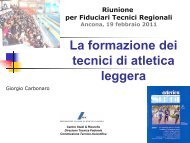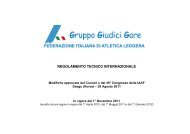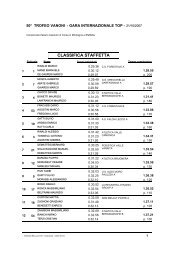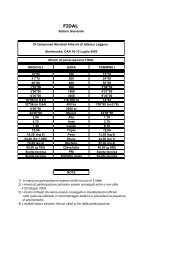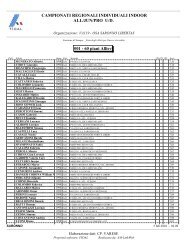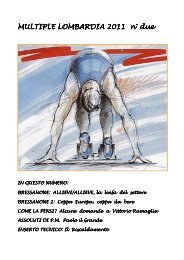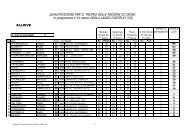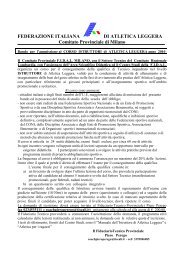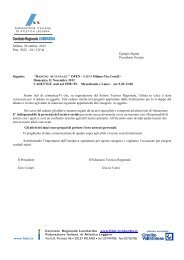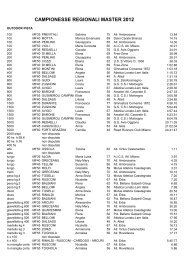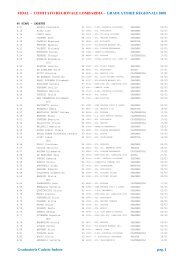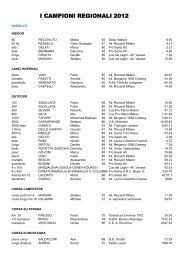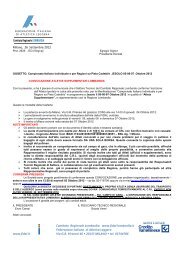UKA/London Marathon Altitude Programme ... - Fidal Lombardia
UKA/London Marathon Altitude Programme ... - Fidal Lombardia
UKA/London Marathon Altitude Programme ... - Fidal Lombardia
Create successful ePaper yourself
Turn your PDF publications into a flip-book with our unique Google optimized e-Paper software.
6.<br />
CASE STUdy:<br />
hELEN CLIThErOE,<br />
IMpACT OF ALTITUdE TrAINING<br />
ON hEr phySIOLOGICAL prOFILE.<br />
Some of the physiological factors<br />
that are known to be related to<br />
endurance running performance<br />
include: maximal O2 uptake (VO2max),<br />
running economy, and the fractional<br />
utilisation of the VO2max (which is<br />
itself related to markers of blood<br />
lactate accumulation during exercise,<br />
including the lactate threshold<br />
(LT) and lactate turn-point (LTP).<br />
Physiological laboratory testing<br />
measures these factors and repeated<br />
testing provides information on<br />
progression of these key markers<br />
as well assessment of recent<br />
training prescription (including the<br />
impact of training practices such<br />
as altitude training). This brief case<br />
study of Helen Clitheroe is to provide<br />
a specific example of the impact<br />
altitude training can have on the<br />
physiology of an athlete with particular<br />
reference to racing performance.<br />
<strong>Altitude</strong> training<br />
From a physiological perspective<br />
the main benefit of altitude training<br />
is to increase the number of red<br />
blood cells (haemoglobin mass).<br />
Red blood cells are the vehicle by<br />
which oxygen is delivered round<br />
the body to the working muscles; in<br />
general terms the more red blood<br />
cells the greater the aerobic work<br />
capacity. For example an increase in<br />
haemoglobin concentration of 0.3 g/<br />
dL will theoretically result in a 1%<br />
improvement in VO2max. There are<br />
also other physiological benefits<br />
from living and/or exercising in a low<br />
oxygen environment. For example<br />
altitude training can generally<br />
enhance many other key aerobic<br />
elements such as increased capillary<br />
number and length, increased<br />
number of mitochondria, improved<br />
blood lactate removal and improved<br />
muscle buffer capacity to name a few.<br />
physiology of helen Clitheroe<br />
Helen has had physiological testing<br />
completed for a number of years<br />
that consists of a warm up of 10 min<br />
followed by a multi-stage incremental<br />
treadmill protocol, typically involving<br />
5-7 exercise stages, each of 3 min<br />
duration. The test is designed to<br />
monitor progression in key variables<br />
(see above) and also to generate<br />
Blood (La) (mM)<br />
10<br />
8<br />
6<br />
4<br />
2<br />
0<br />
Table 1: Key physiological markers over a series of tests.<br />
<strong>UKA</strong>/<strong>London</strong> MARAthon (LM) ALtItUde tRAInIng CAMP AnnUAL RePoRt | 9<br />
accurate training zones by measuring<br />
blood lactate concentration, heart<br />
rate and oxygen uptake throughout<br />
the test. Shifting the LT and/or LTP<br />
to a higher speed is an important<br />
goal of endurance training. The<br />
lactate concentration at any speed<br />
should be lower (downward shift in<br />
the lactate curve) and the LT and<br />
LTP should occur at higher speeds<br />
(rightward shift in the lactate<br />
curve) with endurance training. In<br />
addition, HR should be lower for a<br />
given speed (downward shift in HR<br />
curve). Figure 2 and Table 1 detail<br />
(La)-Mar 11 (La)-Dec 10 (La)-Jan 08 (La)-Mar 07<br />
HR-Mar 11 HR-Dec 10 HR-Jan 08 HR-Mar 07<br />
13 14 15 16 17<br />
Speed (km/h)<br />
18 19 20 21<br />
Figure 2: Aerobic profile over a series of tests.<br />
Test: 1 2 3 4<br />
date: Mar-11 dec-10 Jan-08 Mar-07<br />
Body mass (kg): 57.4 58.4 59.0 58.9<br />
LT (km/h): 17.0 16.5 16.0 16.0<br />
LTP (km/h): 19.0 18.5 18.0 18.0<br />
Economy (mL O2/kg/km): 214 207 199 199<br />
VO2max (mL/kg/min): 76 73 70 66<br />
200<br />
150<br />
100<br />
50<br />
0<br />
Heart Rate (beats/min)



